A Critical Analysis of the Ethical Concerns in Shaping Public Opinion
VerifiedAdded on 2023/06/15
|8
|2528
|163
Essay
AI Summary
This essay delves into the ethical considerations surrounding the creation of public opinion, particularly on sensitive issues like abortion and euthanasia, highlighting the tension between public sentiment and ethical principles. It examines Habermas' communicative ethics and the concept of the public sphere, emphasizing the importance of ethical scrutiny in public discourse. The essay discusses how media platforms influence public opinion and the potential for ethical dilemmas, citing the example of abortion laws in Ireland. It further explores Habermas' theories on the relationship between social science and modern societies, contrasting them with scholars' arguments and Ulrich Beck's concept of a risk society. The essay concludes by examining the role of public discourse and the potential risks of misinformation in shaping public opinion, particularly in the context of the 'cash for comment' affair, emphasizing the importance of ethical considerations in public relations and policy-making.
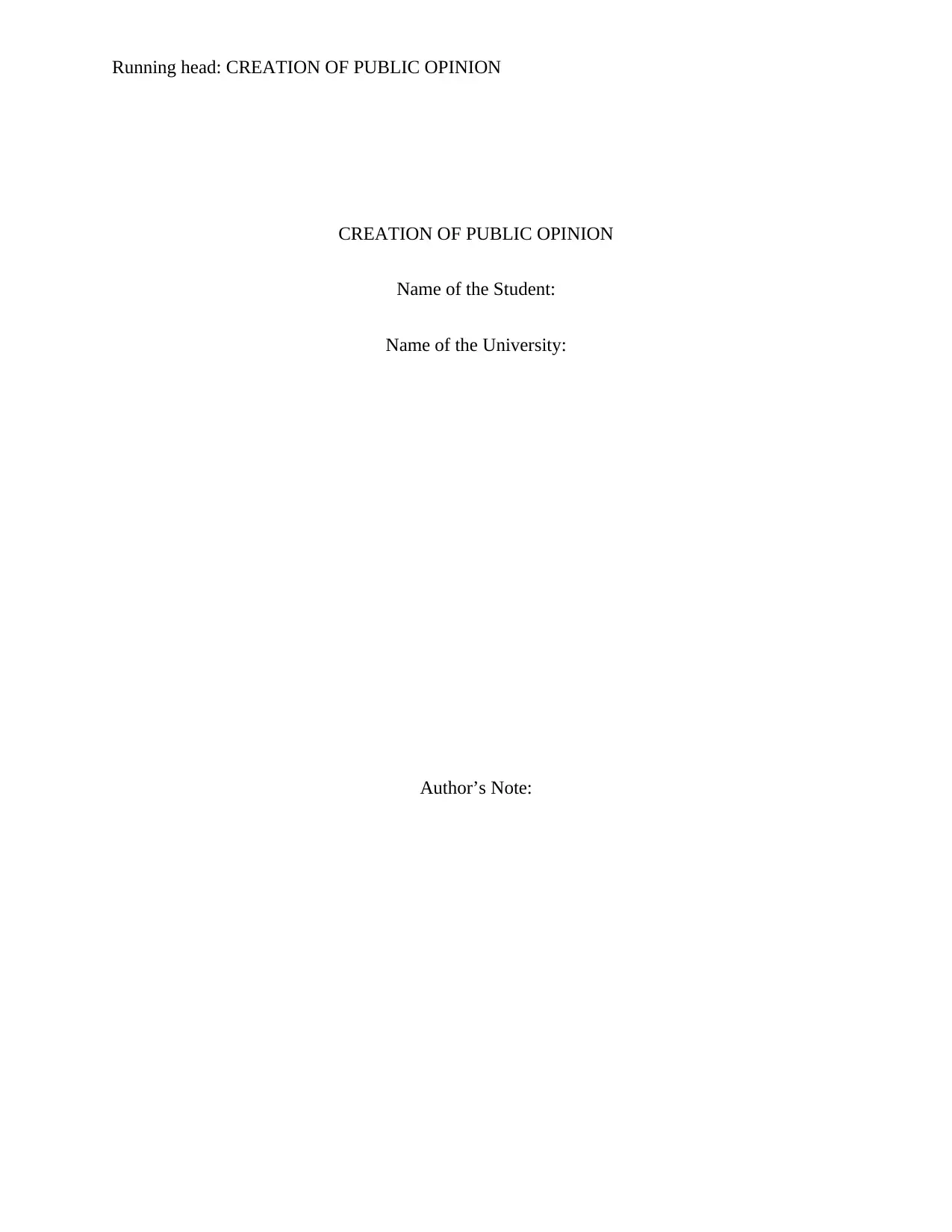
Running head: CREATION OF PUBLIC OPINION
CREATION OF PUBLIC OPINION
Name of the Student:
Name of the University:
Author’s Note:
CREATION OF PUBLIC OPINION
Name of the Student:
Name of the University:
Author’s Note:
Paraphrase This Document
Need a fresh take? Get an instant paraphrase of this document with our AI Paraphraser
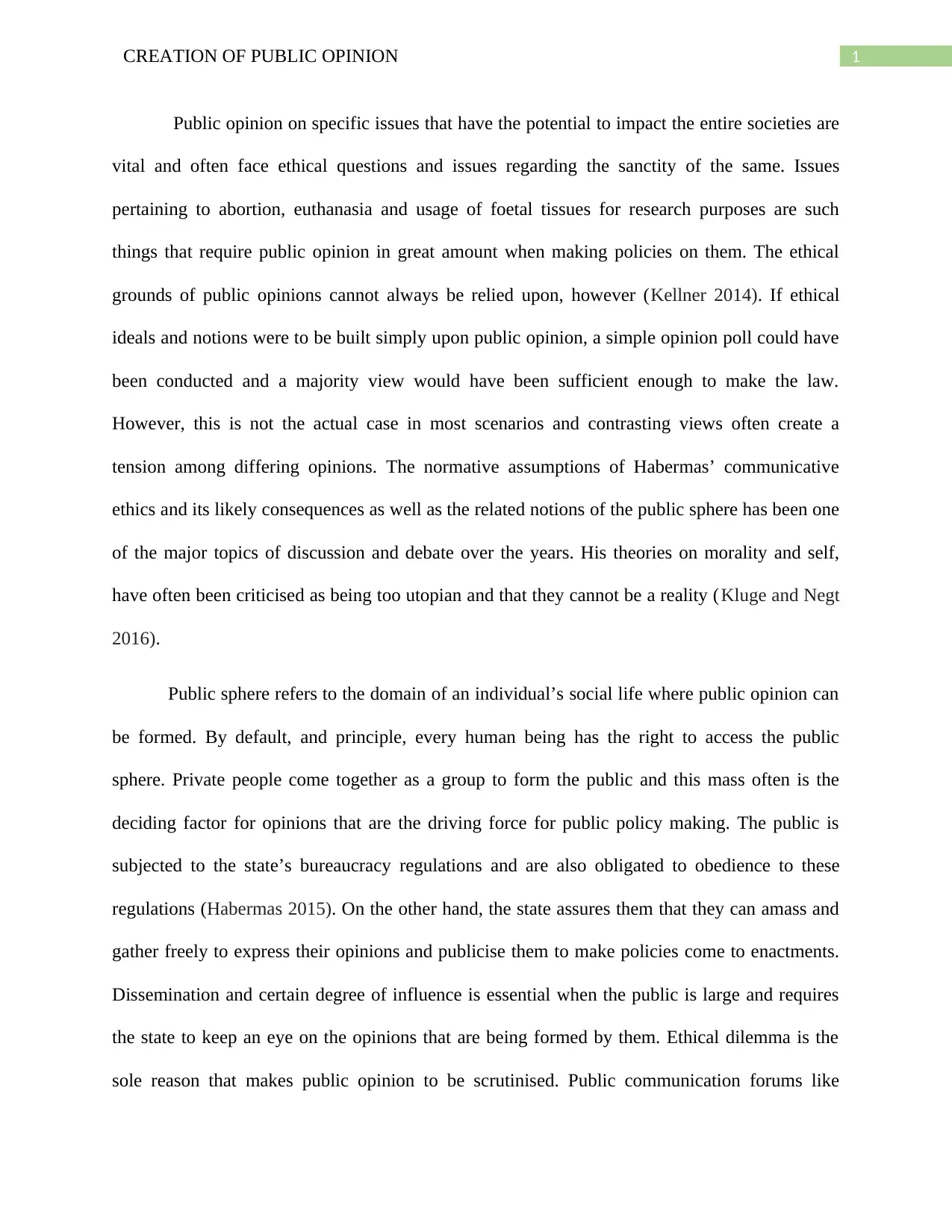
1CREATION OF PUBLIC OPINION
Public opinion on specific issues that have the potential to impact the entire societies are
vital and often face ethical questions and issues regarding the sanctity of the same. Issues
pertaining to abortion, euthanasia and usage of foetal tissues for research purposes are such
things that require public opinion in great amount when making policies on them. The ethical
grounds of public opinions cannot always be relied upon, however (Kellner 2014). If ethical
ideals and notions were to be built simply upon public opinion, a simple opinion poll could have
been conducted and a majority view would have been sufficient enough to make the law.
However, this is not the actual case in most scenarios and contrasting views often create a
tension among differing opinions. The normative assumptions of Habermas’ communicative
ethics and its likely consequences as well as the related notions of the public sphere has been one
of the major topics of discussion and debate over the years. His theories on morality and self,
have often been criticised as being too utopian and that they cannot be a reality (Kluge and Negt
2016).
Public sphere refers to the domain of an individual’s social life where public opinion can
be formed. By default, and principle, every human being has the right to access the public
sphere. Private people come together as a group to form the public and this mass often is the
deciding factor for opinions that are the driving force for public policy making. The public is
subjected to the state’s bureaucracy regulations and are also obligated to obedience to these
regulations (Habermas 2015). On the other hand, the state assures them that they can amass and
gather freely to express their opinions and publicise them to make policies come to enactments.
Dissemination and certain degree of influence is essential when the public is large and requires
the state to keep an eye on the opinions that are being formed by them. Ethical dilemma is the
sole reason that makes public opinion to be scrutinised. Public communication forums like
Public opinion on specific issues that have the potential to impact the entire societies are
vital and often face ethical questions and issues regarding the sanctity of the same. Issues
pertaining to abortion, euthanasia and usage of foetal tissues for research purposes are such
things that require public opinion in great amount when making policies on them. The ethical
grounds of public opinions cannot always be relied upon, however (Kellner 2014). If ethical
ideals and notions were to be built simply upon public opinion, a simple opinion poll could have
been conducted and a majority view would have been sufficient enough to make the law.
However, this is not the actual case in most scenarios and contrasting views often create a
tension among differing opinions. The normative assumptions of Habermas’ communicative
ethics and its likely consequences as well as the related notions of the public sphere has been one
of the major topics of discussion and debate over the years. His theories on morality and self,
have often been criticised as being too utopian and that they cannot be a reality (Kluge and Negt
2016).
Public sphere refers to the domain of an individual’s social life where public opinion can
be formed. By default, and principle, every human being has the right to access the public
sphere. Private people come together as a group to form the public and this mass often is the
deciding factor for opinions that are the driving force for public policy making. The public is
subjected to the state’s bureaucracy regulations and are also obligated to obedience to these
regulations (Habermas 2015). On the other hand, the state assures them that they can amass and
gather freely to express their opinions and publicise them to make policies come to enactments.
Dissemination and certain degree of influence is essential when the public is large and requires
the state to keep an eye on the opinions that are being formed by them. Ethical dilemma is the
sole reason that makes public opinion to be scrutinised. Public communication forums like
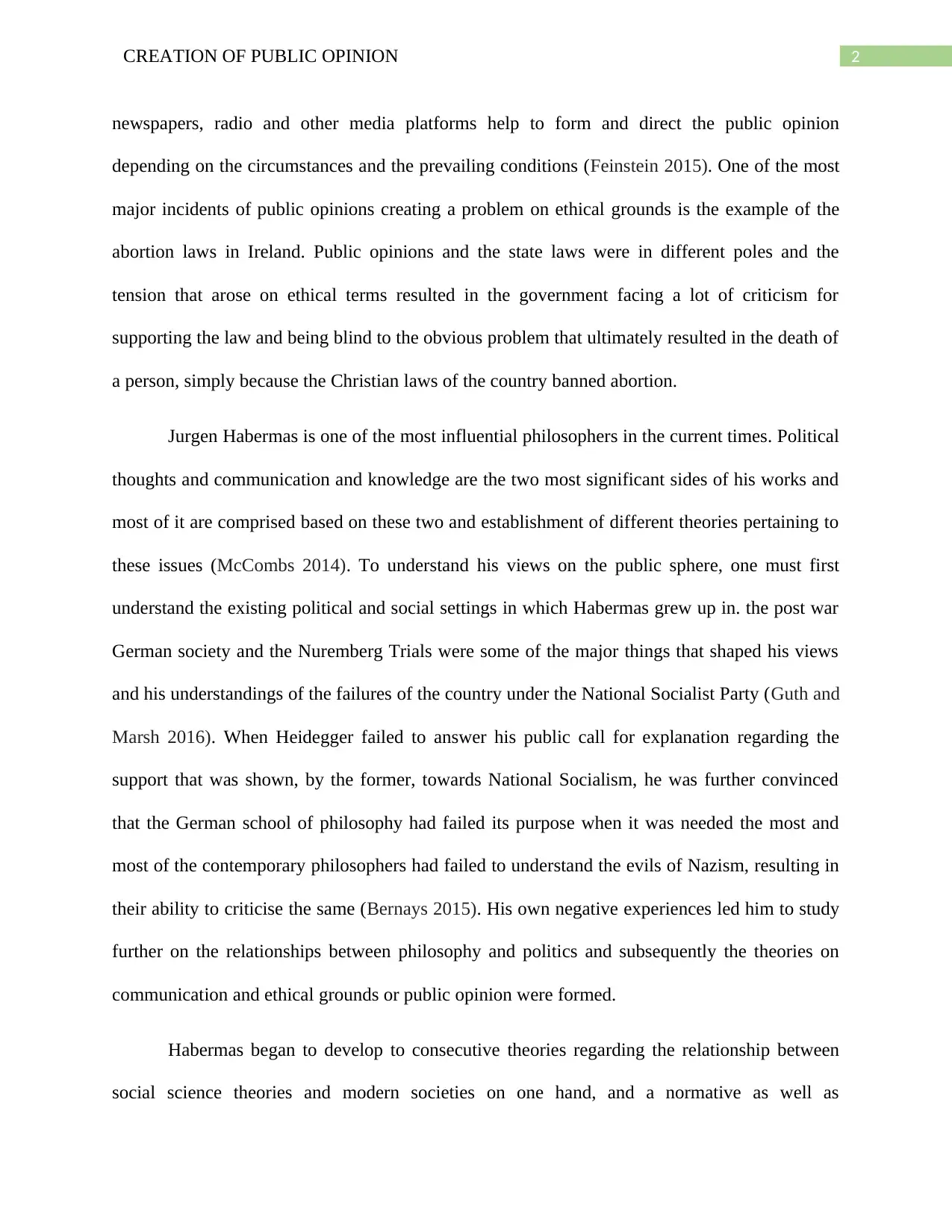
2CREATION OF PUBLIC OPINION
newspapers, radio and other media platforms help to form and direct the public opinion
depending on the circumstances and the prevailing conditions (Feinstein 2015). One of the most
major incidents of public opinions creating a problem on ethical grounds is the example of the
abortion laws in Ireland. Public opinions and the state laws were in different poles and the
tension that arose on ethical terms resulted in the government facing a lot of criticism for
supporting the law and being blind to the obvious problem that ultimately resulted in the death of
a person, simply because the Christian laws of the country banned abortion.
Jurgen Habermas is one of the most influential philosophers in the current times. Political
thoughts and communication and knowledge are the two most significant sides of his works and
most of it are comprised based on these two and establishment of different theories pertaining to
these issues (McCombs 2014). To understand his views on the public sphere, one must first
understand the existing political and social settings in which Habermas grew up in. the post war
German society and the Nuremberg Trials were some of the major things that shaped his views
and his understandings of the failures of the country under the National Socialist Party (Guth and
Marsh 2016). When Heidegger failed to answer his public call for explanation regarding the
support that was shown, by the former, towards National Socialism, he was further convinced
that the German school of philosophy had failed its purpose when it was needed the most and
most of the contemporary philosophers had failed to understand the evils of Nazism, resulting in
their ability to criticise the same (Bernays 2015). His own negative experiences led him to study
further on the relationships between philosophy and politics and subsequently the theories on
communication and ethical grounds or public opinion were formed.
Habermas began to develop to consecutive theories regarding the relationship between
social science theories and modern societies on one hand, and a normative as well as
newspapers, radio and other media platforms help to form and direct the public opinion
depending on the circumstances and the prevailing conditions (Feinstein 2015). One of the most
major incidents of public opinions creating a problem on ethical grounds is the example of the
abortion laws in Ireland. Public opinions and the state laws were in different poles and the
tension that arose on ethical terms resulted in the government facing a lot of criticism for
supporting the law and being blind to the obvious problem that ultimately resulted in the death of
a person, simply because the Christian laws of the country banned abortion.
Jurgen Habermas is one of the most influential philosophers in the current times. Political
thoughts and communication and knowledge are the two most significant sides of his works and
most of it are comprised based on these two and establishment of different theories pertaining to
these issues (McCombs 2014). To understand his views on the public sphere, one must first
understand the existing political and social settings in which Habermas grew up in. the post war
German society and the Nuremberg Trials were some of the major things that shaped his views
and his understandings of the failures of the country under the National Socialist Party (Guth and
Marsh 2016). When Heidegger failed to answer his public call for explanation regarding the
support that was shown, by the former, towards National Socialism, he was further convinced
that the German school of philosophy had failed its purpose when it was needed the most and
most of the contemporary philosophers had failed to understand the evils of Nazism, resulting in
their ability to criticise the same (Bernays 2015). His own negative experiences led him to study
further on the relationships between philosophy and politics and subsequently the theories on
communication and ethical grounds or public opinion were formed.
Habermas began to develop to consecutive theories regarding the relationship between
social science theories and modern societies on one hand, and a normative as well as
⊘ This is a preview!⊘
Do you want full access?
Subscribe today to unlock all pages.

Trusted by 1+ million students worldwide
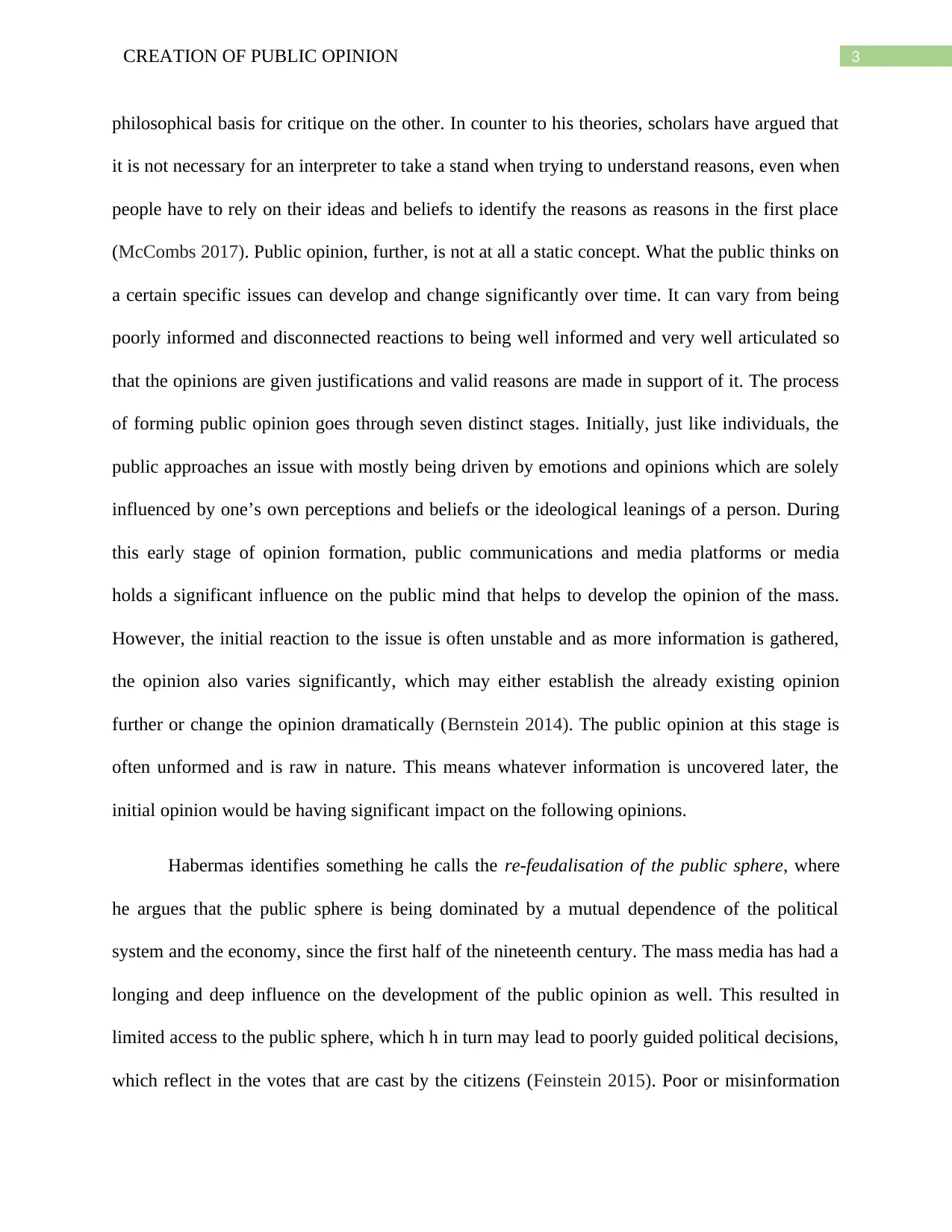
3CREATION OF PUBLIC OPINION
philosophical basis for critique on the other. In counter to his theories, scholars have argued that
it is not necessary for an interpreter to take a stand when trying to understand reasons, even when
people have to rely on their ideas and beliefs to identify the reasons as reasons in the first place
(McCombs 2017). Public opinion, further, is not at all a static concept. What the public thinks on
a certain specific issues can develop and change significantly over time. It can vary from being
poorly informed and disconnected reactions to being well informed and very well articulated so
that the opinions are given justifications and valid reasons are made in support of it. The process
of forming public opinion goes through seven distinct stages. Initially, just like individuals, the
public approaches an issue with mostly being driven by emotions and opinions which are solely
influenced by one’s own perceptions and beliefs or the ideological leanings of a person. During
this early stage of opinion formation, public communications and media platforms or media
holds a significant influence on the public mind that helps to develop the opinion of the mass.
However, the initial reaction to the issue is often unstable and as more information is gathered,
the opinion also varies significantly, which may either establish the already existing opinion
further or change the opinion dramatically (Bernstein 2014). The public opinion at this stage is
often unformed and is raw in nature. This means whatever information is uncovered later, the
initial opinion would be having significant impact on the following opinions.
Habermas identifies something he calls the re-feudalisation of the public sphere, where
he argues that the public sphere is being dominated by a mutual dependence of the political
system and the economy, since the first half of the nineteenth century. The mass media has had a
longing and deep influence on the development of the public opinion as well. This resulted in
limited access to the public sphere, which h in turn may lead to poorly guided political decisions,
which reflect in the votes that are cast by the citizens (Feinstein 2015). Poor or misinformation
philosophical basis for critique on the other. In counter to his theories, scholars have argued that
it is not necessary for an interpreter to take a stand when trying to understand reasons, even when
people have to rely on their ideas and beliefs to identify the reasons as reasons in the first place
(McCombs 2017). Public opinion, further, is not at all a static concept. What the public thinks on
a certain specific issues can develop and change significantly over time. It can vary from being
poorly informed and disconnected reactions to being well informed and very well articulated so
that the opinions are given justifications and valid reasons are made in support of it. The process
of forming public opinion goes through seven distinct stages. Initially, just like individuals, the
public approaches an issue with mostly being driven by emotions and opinions which are solely
influenced by one’s own perceptions and beliefs or the ideological leanings of a person. During
this early stage of opinion formation, public communications and media platforms or media
holds a significant influence on the public mind that helps to develop the opinion of the mass.
However, the initial reaction to the issue is often unstable and as more information is gathered,
the opinion also varies significantly, which may either establish the already existing opinion
further or change the opinion dramatically (Bernstein 2014). The public opinion at this stage is
often unformed and is raw in nature. This means whatever information is uncovered later, the
initial opinion would be having significant impact on the following opinions.
Habermas identifies something he calls the re-feudalisation of the public sphere, where
he argues that the public sphere is being dominated by a mutual dependence of the political
system and the economy, since the first half of the nineteenth century. The mass media has had a
longing and deep influence on the development of the public opinion as well. This resulted in
limited access to the public sphere, which h in turn may lead to poorly guided political decisions,
which reflect in the votes that are cast by the citizens (Feinstein 2015). Poor or misinformation
Paraphrase This Document
Need a fresh take? Get an instant paraphrase of this document with our AI Paraphraser
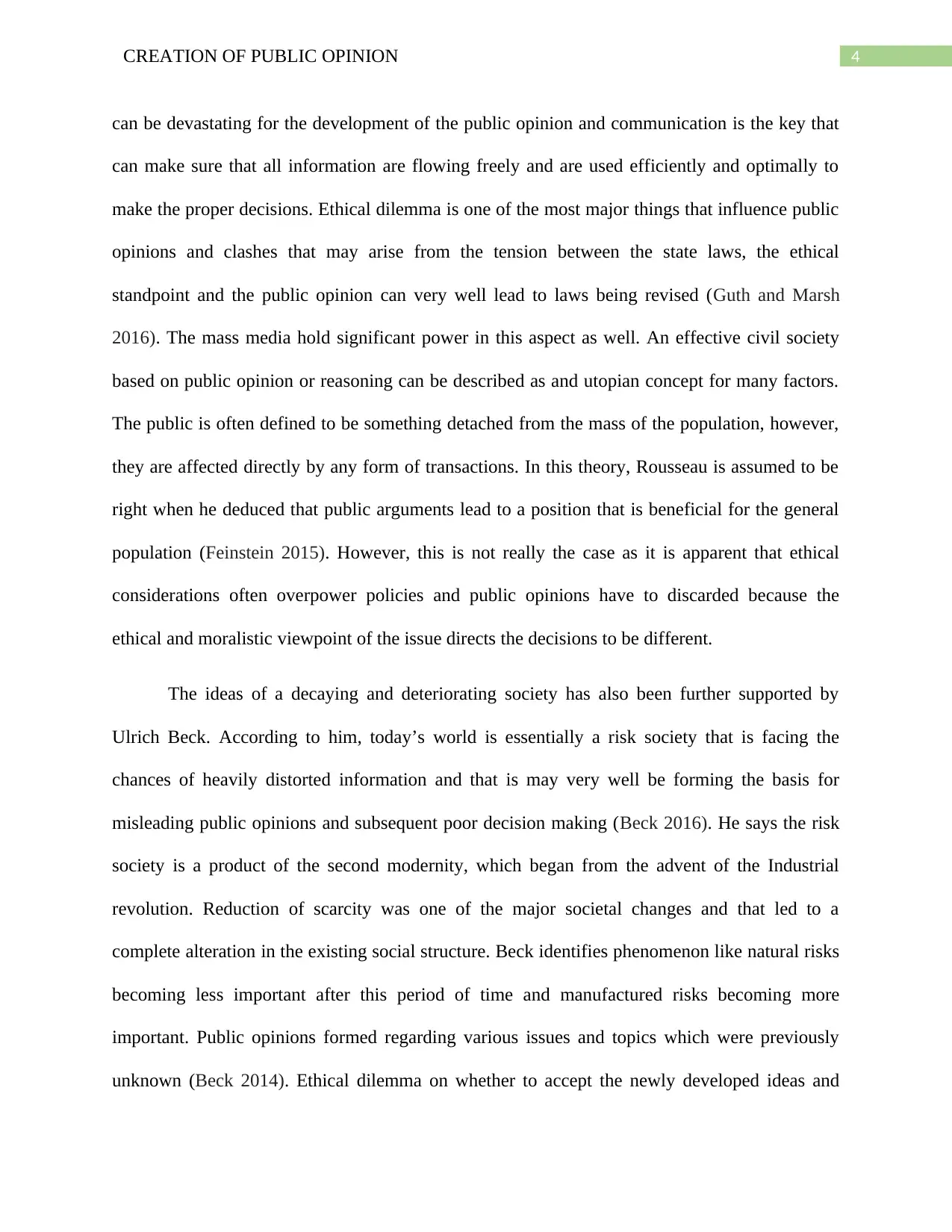
4CREATION OF PUBLIC OPINION
can be devastating for the development of the public opinion and communication is the key that
can make sure that all information are flowing freely and are used efficiently and optimally to
make the proper decisions. Ethical dilemma is one of the most major things that influence public
opinions and clashes that may arise from the tension between the state laws, the ethical
standpoint and the public opinion can very well lead to laws being revised (Guth and Marsh
2016). The mass media hold significant power in this aspect as well. An effective civil society
based on public opinion or reasoning can be described as and utopian concept for many factors.
The public is often defined to be something detached from the mass of the population, however,
they are affected directly by any form of transactions. In this theory, Rousseau is assumed to be
right when he deduced that public arguments lead to a position that is beneficial for the general
population (Feinstein 2015). However, this is not really the case as it is apparent that ethical
considerations often overpower policies and public opinions have to discarded because the
ethical and moralistic viewpoint of the issue directs the decisions to be different.
The ideas of a decaying and deteriorating society has also been further supported by
Ulrich Beck. According to him, today’s world is essentially a risk society that is facing the
chances of heavily distorted information and that is may very well be forming the basis for
misleading public opinions and subsequent poor decision making (Beck 2016). He says the risk
society is a product of the second modernity, which began from the advent of the Industrial
revolution. Reduction of scarcity was one of the major societal changes and that led to a
complete alteration in the existing social structure. Beck identifies phenomenon like natural risks
becoming less important after this period of time and manufactured risks becoming more
important. Public opinions formed regarding various issues and topics which were previously
unknown (Beck 2014). Ethical dilemma on whether to accept the newly developed ideas and
can be devastating for the development of the public opinion and communication is the key that
can make sure that all information are flowing freely and are used efficiently and optimally to
make the proper decisions. Ethical dilemma is one of the most major things that influence public
opinions and clashes that may arise from the tension between the state laws, the ethical
standpoint and the public opinion can very well lead to laws being revised (Guth and Marsh
2016). The mass media hold significant power in this aspect as well. An effective civil society
based on public opinion or reasoning can be described as and utopian concept for many factors.
The public is often defined to be something detached from the mass of the population, however,
they are affected directly by any form of transactions. In this theory, Rousseau is assumed to be
right when he deduced that public arguments lead to a position that is beneficial for the general
population (Feinstein 2015). However, this is not really the case as it is apparent that ethical
considerations often overpower policies and public opinions have to discarded because the
ethical and moralistic viewpoint of the issue directs the decisions to be different.
The ideas of a decaying and deteriorating society has also been further supported by
Ulrich Beck. According to him, today’s world is essentially a risk society that is facing the
chances of heavily distorted information and that is may very well be forming the basis for
misleading public opinions and subsequent poor decision making (Beck 2016). He says the risk
society is a product of the second modernity, which began from the advent of the Industrial
revolution. Reduction of scarcity was one of the major societal changes and that led to a
complete alteration in the existing social structure. Beck identifies phenomenon like natural risks
becoming less important after this period of time and manufactured risks becoming more
important. Public opinions formed regarding various issues and topics which were previously
unknown (Beck 2014). Ethical dilemma on whether to accept the newly developed ideas and
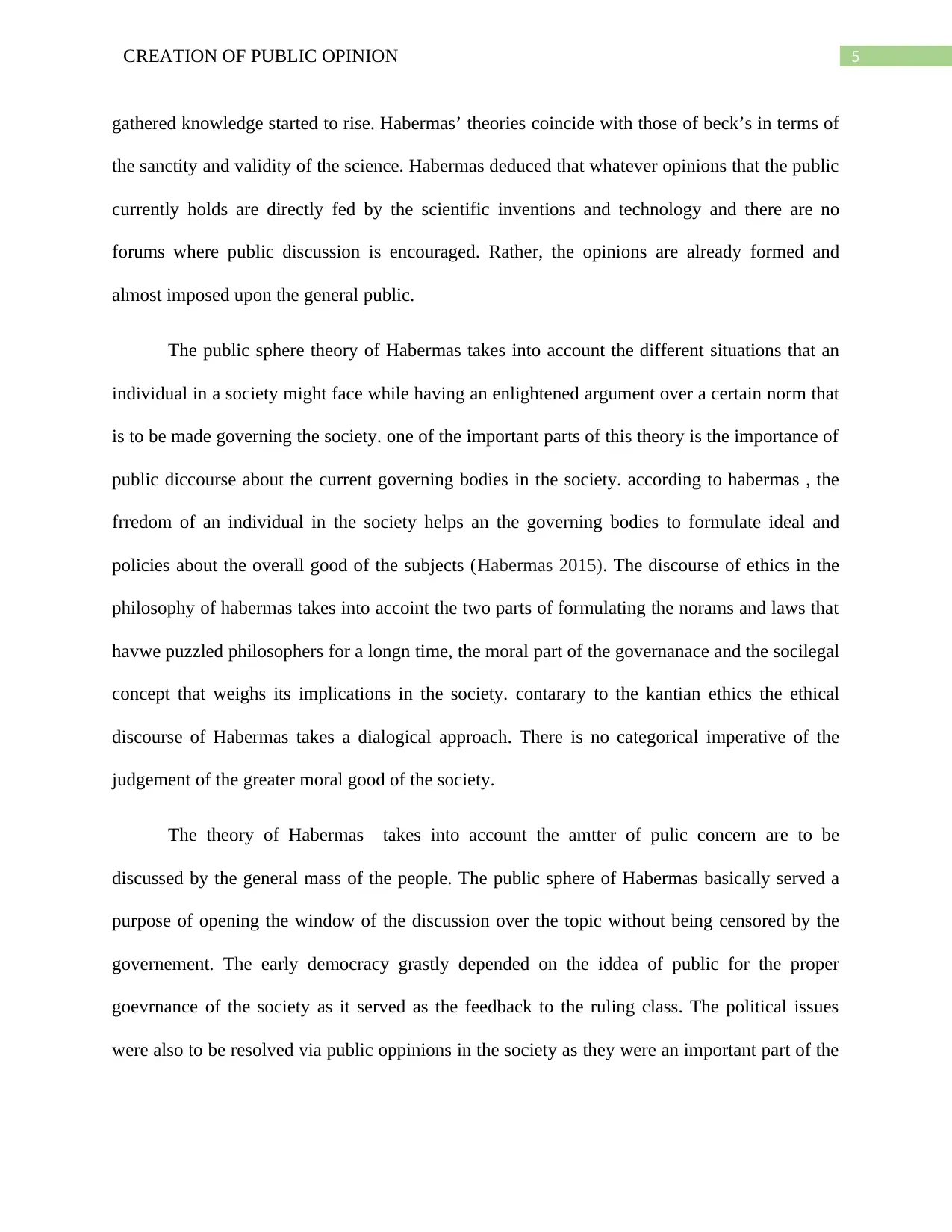
5CREATION OF PUBLIC OPINION
gathered knowledge started to rise. Habermas’ theories coincide with those of beck’s in terms of
the sanctity and validity of the science. Habermas deduced that whatever opinions that the public
currently holds are directly fed by the scientific inventions and technology and there are no
forums where public discussion is encouraged. Rather, the opinions are already formed and
almost imposed upon the general public.
The public sphere theory of Habermas takes into account the different situations that an
individual in a society might face while having an enlightened argument over a certain norm that
is to be made governing the society. one of the important parts of this theory is the importance of
public diccourse about the current governing bodies in the society. according to habermas , the
frredom of an individual in the society helps an the governing bodies to formulate ideal and
policies about the overall good of the subjects (Habermas 2015). The discourse of ethics in the
philosophy of habermas takes into accoint the two parts of formulating the norams and laws that
havwe puzzled philosophers for a longn time, the moral part of the governanace and the socilegal
concept that weighs its implications in the society. contarary to the kantian ethics the ethical
discourse of Habermas takes a dialogical approach. There is no categorical imperative of the
judgement of the greater moral good of the society.
The theory of Habermas takes into account the amtter of pulic concern are to be
discussed by the general mass of the people. The public sphere of Habermas basically served a
purpose of opening the window of the discussion over the topic without being censored by the
governement. The early democracy grastly depended on the iddea of public for the proper
goevrnance of the society as it served as the feedback to the ruling class. The political issues
were also to be resolved via public oppinions in the society as they were an important part of the
gathered knowledge started to rise. Habermas’ theories coincide with those of beck’s in terms of
the sanctity and validity of the science. Habermas deduced that whatever opinions that the public
currently holds are directly fed by the scientific inventions and technology and there are no
forums where public discussion is encouraged. Rather, the opinions are already formed and
almost imposed upon the general public.
The public sphere theory of Habermas takes into account the different situations that an
individual in a society might face while having an enlightened argument over a certain norm that
is to be made governing the society. one of the important parts of this theory is the importance of
public diccourse about the current governing bodies in the society. according to habermas , the
frredom of an individual in the society helps an the governing bodies to formulate ideal and
policies about the overall good of the subjects (Habermas 2015). The discourse of ethics in the
philosophy of habermas takes into accoint the two parts of formulating the norams and laws that
havwe puzzled philosophers for a longn time, the moral part of the governanace and the socilegal
concept that weighs its implications in the society. contarary to the kantian ethics the ethical
discourse of Habermas takes a dialogical approach. There is no categorical imperative of the
judgement of the greater moral good of the society.
The theory of Habermas takes into account the amtter of pulic concern are to be
discussed by the general mass of the people. The public sphere of Habermas basically served a
purpose of opening the window of the discussion over the topic without being censored by the
governement. The early democracy grastly depended on the iddea of public for the proper
goevrnance of the society as it served as the feedback to the ruling class. The political issues
were also to be resolved via public oppinions in the society as they were an important part of the
⊘ This is a preview!⊘
Do you want full access?
Subscribe today to unlock all pages.

Trusted by 1+ million students worldwide
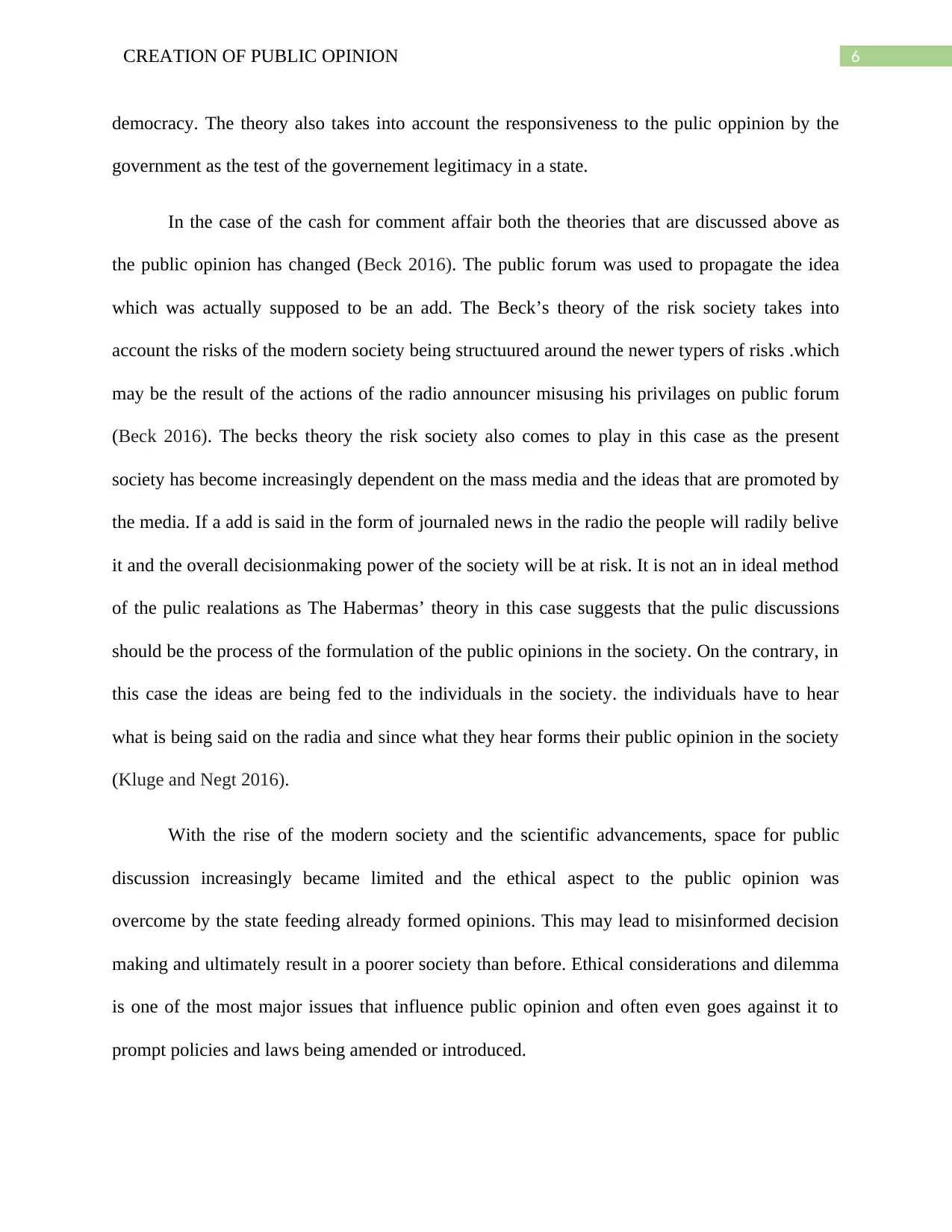
6CREATION OF PUBLIC OPINION
democracy. The theory also takes into account the responsiveness to the pulic oppinion by the
government as the test of the governement legitimacy in a state.
In the case of the cash for comment affair both the theories that are discussed above as
the public opinion has changed (Beck 2016). The public forum was used to propagate the idea
which was actually supposed to be an add. The Beck’s theory of the risk society takes into
account the risks of the modern society being structuured around the newer typers of risks .which
may be the result of the actions of the radio announcer misusing his privilages on public forum
(Beck 2016). The becks theory the risk society also comes to play in this case as the present
society has become increasingly dependent on the mass media and the ideas that are promoted by
the media. If a add is said in the form of journaled news in the radio the people will radily belive
it and the overall decisionmaking power of the society will be at risk. It is not an in ideal method
of the pulic realations as The Habermas’ theory in this case suggests that the pulic discussions
should be the process of the formulation of the public opinions in the society. On the contrary, in
this case the ideas are being fed to the individuals in the society. the individuals have to hear
what is being said on the radia and since what they hear forms their public opinion in the society
(Kluge and Negt 2016).
With the rise of the modern society and the scientific advancements, space for public
discussion increasingly became limited and the ethical aspect to the public opinion was
overcome by the state feeding already formed opinions. This may lead to misinformed decision
making and ultimately result in a poorer society than before. Ethical considerations and dilemma
is one of the most major issues that influence public opinion and often even goes against it to
prompt policies and laws being amended or introduced.
democracy. The theory also takes into account the responsiveness to the pulic oppinion by the
government as the test of the governement legitimacy in a state.
In the case of the cash for comment affair both the theories that are discussed above as
the public opinion has changed (Beck 2016). The public forum was used to propagate the idea
which was actually supposed to be an add. The Beck’s theory of the risk society takes into
account the risks of the modern society being structuured around the newer typers of risks .which
may be the result of the actions of the radio announcer misusing his privilages on public forum
(Beck 2016). The becks theory the risk society also comes to play in this case as the present
society has become increasingly dependent on the mass media and the ideas that are promoted by
the media. If a add is said in the form of journaled news in the radio the people will radily belive
it and the overall decisionmaking power of the society will be at risk. It is not an in ideal method
of the pulic realations as The Habermas’ theory in this case suggests that the pulic discussions
should be the process of the formulation of the public opinions in the society. On the contrary, in
this case the ideas are being fed to the individuals in the society. the individuals have to hear
what is being said on the radia and since what they hear forms their public opinion in the society
(Kluge and Negt 2016).
With the rise of the modern society and the scientific advancements, space for public
discussion increasingly became limited and the ethical aspect to the public opinion was
overcome by the state feeding already formed opinions. This may lead to misinformed decision
making and ultimately result in a poorer society than before. Ethical considerations and dilemma
is one of the most major issues that influence public opinion and often even goes against it to
prompt policies and laws being amended or introduced.
Paraphrase This Document
Need a fresh take? Get an instant paraphrase of this document with our AI Paraphraser
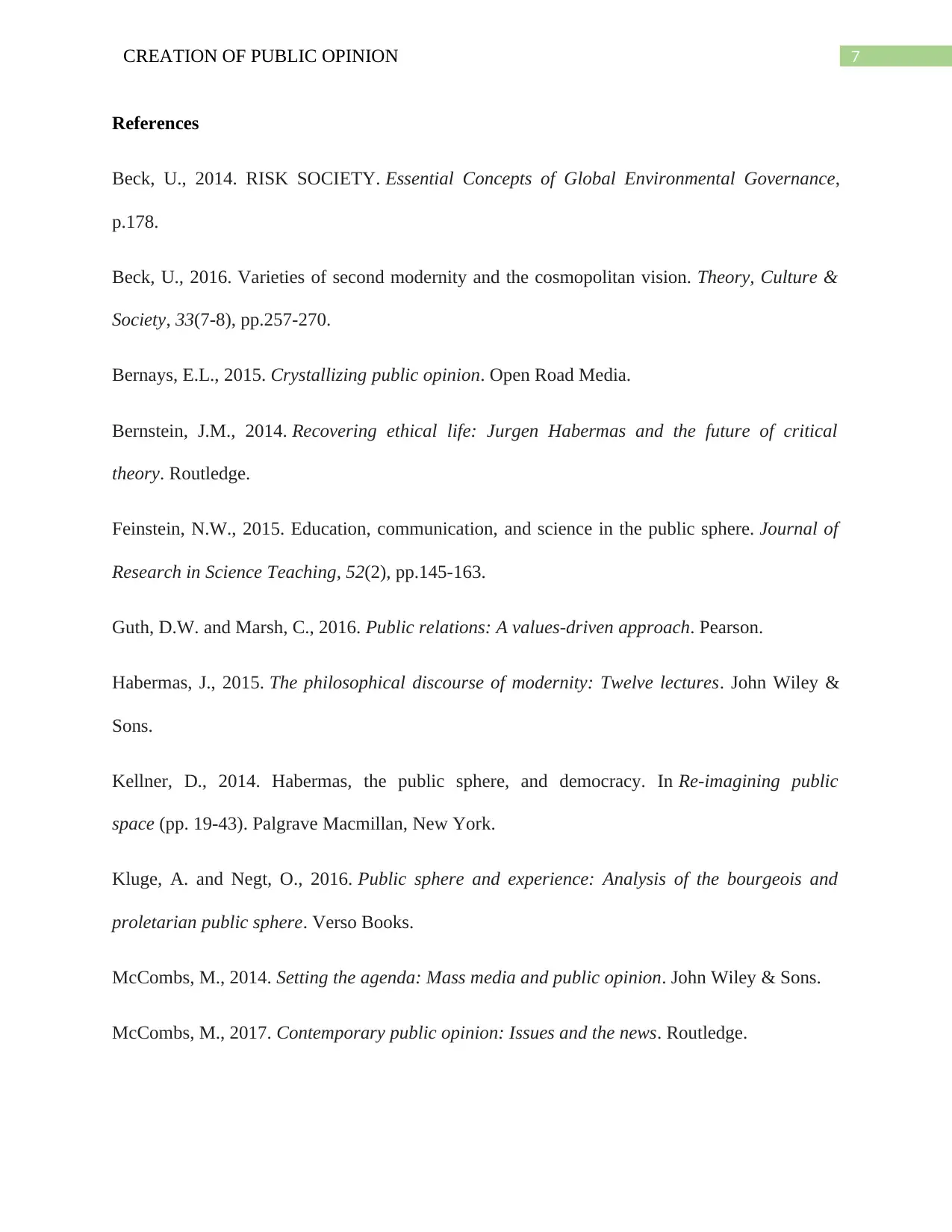
7CREATION OF PUBLIC OPINION
References
Beck, U., 2014. RISK SOCIETY. Essential Concepts of Global Environmental Governance,
p.178.
Beck, U., 2016. Varieties of second modernity and the cosmopolitan vision. Theory, Culture &
Society, 33(7-8), pp.257-270.
Bernays, E.L., 2015. Crystallizing public opinion. Open Road Media.
Bernstein, J.M., 2014. Recovering ethical life: Jurgen Habermas and the future of critical
theory. Routledge.
Feinstein, N.W., 2015. Education, communication, and science in the public sphere. Journal of
Research in Science Teaching, 52(2), pp.145-163.
Guth, D.W. and Marsh, C., 2016. Public relations: A values-driven approach. Pearson.
Habermas, J., 2015. The philosophical discourse of modernity: Twelve lectures. John Wiley &
Sons.
Kellner, D., 2014. Habermas, the public sphere, and democracy. In Re-imagining public
space (pp. 19-43). Palgrave Macmillan, New York.
Kluge, A. and Negt, O., 2016. Public sphere and experience: Analysis of the bourgeois and
proletarian public sphere. Verso Books.
McCombs, M., 2014. Setting the agenda: Mass media and public opinion. John Wiley & Sons.
McCombs, M., 2017. Contemporary public opinion: Issues and the news. Routledge.
References
Beck, U., 2014. RISK SOCIETY. Essential Concepts of Global Environmental Governance,
p.178.
Beck, U., 2016. Varieties of second modernity and the cosmopolitan vision. Theory, Culture &
Society, 33(7-8), pp.257-270.
Bernays, E.L., 2015. Crystallizing public opinion. Open Road Media.
Bernstein, J.M., 2014. Recovering ethical life: Jurgen Habermas and the future of critical
theory. Routledge.
Feinstein, N.W., 2015. Education, communication, and science in the public sphere. Journal of
Research in Science Teaching, 52(2), pp.145-163.
Guth, D.W. and Marsh, C., 2016. Public relations: A values-driven approach. Pearson.
Habermas, J., 2015. The philosophical discourse of modernity: Twelve lectures. John Wiley &
Sons.
Kellner, D., 2014. Habermas, the public sphere, and democracy. In Re-imagining public
space (pp. 19-43). Palgrave Macmillan, New York.
Kluge, A. and Negt, O., 2016. Public sphere and experience: Analysis of the bourgeois and
proletarian public sphere. Verso Books.
McCombs, M., 2014. Setting the agenda: Mass media and public opinion. John Wiley & Sons.
McCombs, M., 2017. Contemporary public opinion: Issues and the news. Routledge.
1 out of 8
Related Documents
Your All-in-One AI-Powered Toolkit for Academic Success.
+13062052269
info@desklib.com
Available 24*7 on WhatsApp / Email
![[object Object]](/_next/static/media/star-bottom.7253800d.svg)
Unlock your academic potential
Copyright © 2020–2025 A2Z Services. All Rights Reserved. Developed and managed by ZUCOL.





